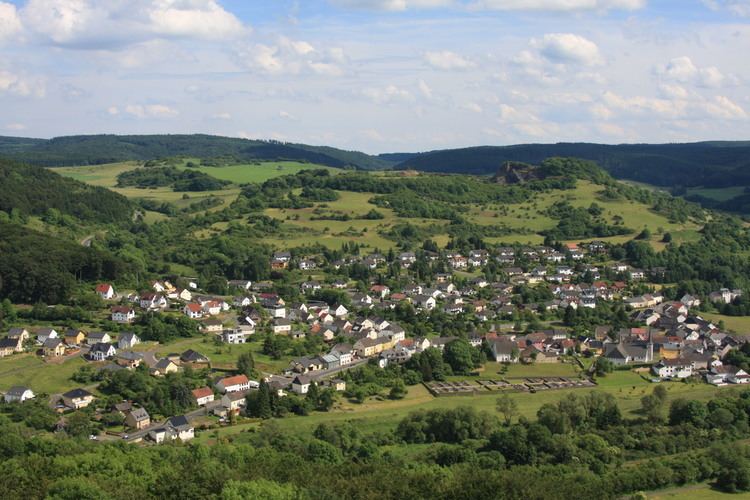Time zone CET/CEST (UTC+1/+2) Area 10.06 km² Population 1,008 (31 Dec 2008) Dialling code 06591 | Elevation 370 m (1,210 ft) Postal codes 54570 Local time Sunday 3:07 AM Postal code 54570 | |
 | ||
Weather 6°C, Wind NE at 11 km/h, 56% Humidity | ||
Pelm is an Ortsgemeinde – a municipality belonging to a Verbandsgemeinde, a kind of collective municipality – in the Vulkaneifel district in Rhineland-Palatinate, Germany. It belongs to the Verbandsgemeinde of Gerolstein, whose seat is in the like-named town.
Contents
- Map of Pelm Germany
- Location
- Neighbouring municipalities
- History
- Municipal council
- Mayor
- Coat of arms
- Buildings
- References
Map of Pelm, Germany
Location
The municipality lies on the river Kyll in the Vulkaneifel, a part of the Eifel known for its volcanic history, geographical and geological features, and even ongoing activity today, including gases that sometimes well up from the earth.
Neighbouring municipalities
Pelm’s neighbours are Gerolstein, Rockeskyll, Berlingen, Dohm-Lammersdorf and Hohenfels-Essingen.
History
Pelm is notable for its connection with ancient history.
Unearthed to the west of the village was a Gallo-Roman sanctuary. It had already been widely destroyed by graverobbers by the time a systematic investigation was done in 1928. More recently, newer information was brought to light by a dig undertaken in 1986 by the Trier Rhenish State Museum. The trapezoidal wall that once bounded the hallowed grounds, whose greatest length is 65 m and whose greatest breadth is 42 m, was built of limestone. Inside is a Gallo-Roman temple with a cella and a passageway in which a limestone tablet was found as early as 1833 inscribed with a dedication to the goddess Caiva. The tablet mentions that a man named Marcus Victorius Polentius granted an endowment of 100,000 sestertii for the temple to Caiva to be built. This inscription has been dated to AD 124.
There were two other temples on the grounds. At one, a fragmentary red sandstone club, likely from a statue of Hercules, was found in 1986. A torso from such a statue was unearthed in 1834, but has since been lost. Other statuary has been found representing Mercury and Venus, for instance.
Coins, too, have been found, from a quinarius minted in Africa in 47 or 46 BC to various coins struck about AD 400. One find, a fibula, dates from early La Tène times.
In the Middle Ages, the village was held by the House of Kasselburg, whose castle seat was in the village. It gave the noble family its name, and is still known today as the Kasselburg.
On 18 May 1897, Pelm was the site of a railway disaster when a troop train crashed into some uncoupled rolling stock causing seven of the train’s coaches to derail. In the accident, ensuing chaos and fire, ten men – nine military personnel and one civilian – were killed. Many more were wounded.
Municipal council
The council is made up of 16 council members, who were elected by proportional representation at the municipal election held on 7 June 2009, and the honorary mayor as chairman.
The municipal election held on 7 June 2009 yielded the following results:
Mayor
Pelm’s mayor is Wolfgang Zaeper (FWG), and his deputies are Helmut Bell (FWG) and Leo Meeth (FWG).
Coat of arms
The German blazon reads: Gespalten von Grün und Silber, über einem von Silber und Blau gespaltenen Wellenbalken zwei goldene Zinnentürme, eine goldene Zinnenmauer flankierend, Tor und Fenster betagleuchtet, hinten ein rotes Vortragkreuz.
The municipality’s arms might in English heraldic language be described thus: Per pale vert a fess wavy abased argent above which a wall flanked by two towers all embattled Or, gate and windows sable, and argent a fess wavy abased conjoined as one to the other azure issuant from which a processional cross gules.
The 1988 Vulkaneifel Yearbook shows different arms for Pelm with the tower-flanked gatehouse as the only charge, issuant from base. The field tinctures was different, too, the gatehouse still being in Or (gold), but the field in sable (black). The composition on the sinister (armsbearer’s left, viewer’s right) side did not appear at all.
Nonetheless, in both forms of the arms, the gatehouse represents the local mediaeval landmark, the Kasselburg (castle).
